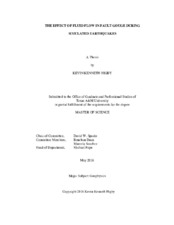| dc.description.abstract | When the frictional strength of a fault zone is met, displacement occurs within the fault zone. Displacement can occur at a seismogenic or aseismic velocity. Seismogenic events cause devastating earthquakes while aseismic activity is the result of low velocity slip events. These slow slip events are thought to be from over pressured pore pressures present in the fault zone.
This work investigates the effect of pore fluid flow within fault gouge during an earthquake by using a grain scale numerical model. Fault gouge is simulated using a Discrete Element Model (DEM) that is coupled with grain motion to generate pressures from fluid flow. We compare the evolution of an earthquake using numerical simulations that began with identical granular arrangements run with a high permeability (drained) and a low permeability (undrained). Drained simulations are defined as those where fluid can flow freely enough such that the slip event is not affected by it. Undrained simulations are those in which pore fluid pressure cannot flow, and the strength of the system is severely affected by pressure perturbations.
Type I events the undrained system reached a lower static strength while Type II events are those where the undrained system achieved a higher static strength. Local granular rearrangements are responsible for the strengthening or weakening of the undrained events.
The slip velocities during a simulated earthquake in a drained system are well modeled by the block slider model with a constant coefficient of dynamic friction. However, a number of undrained earthquakes showed complex slip characteristics including abrupt changes in velocity and a variable dynamic resistance. These slip events resemble creep-like and tremor-like behavior seen in natural subduction zones and caused by pressure perturbations within the gouge zone.
We find fluid pressure perturbations can weaken the static strength of undrained systems, but not always. This shows reductions in pressures play the dominant role in controlling the strength of a system. In addition, the dynamic resistance of complex events is primarily controlled by fluid flow, and not a variable coefficient of dynamic friction. | en |


